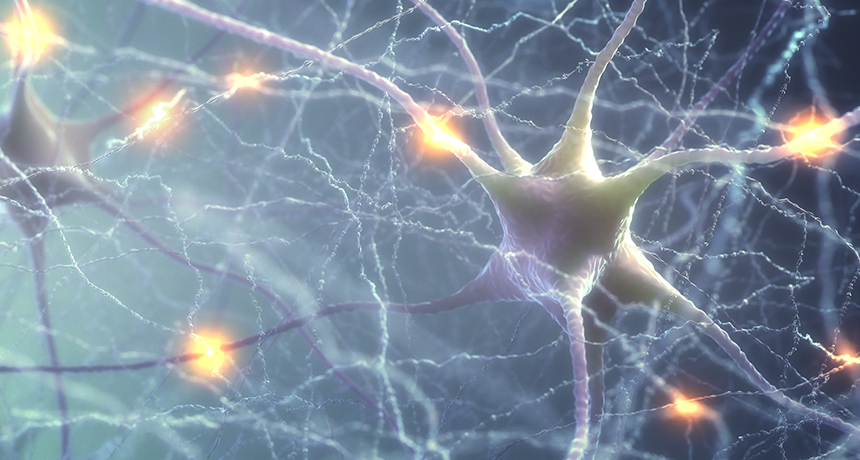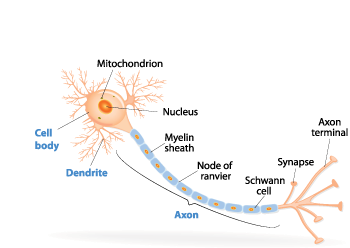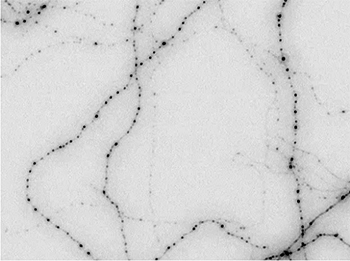Mild brain injury can cause bead-like swellings in brain cells
Mild head hits cause small, temporary swellings in cells — and protein buildups, mouse data show

An artist’s rendering of nerve cells in the brain. A mild head trauma can cause temporary swelling in parts of those cells.
ktsimage/iStockphoto
Playing sports can sometimes lead to an accidental head bump. If it’s severe, this injury may result in a concussion. But even mild head injury can produce small, round but temporary areas of swelling within individual brain cells, a new mouse study finds. Its authors aren’t sure how serious the impacts of this temporary swelling can be, so more work will be needed.
Still, these early data offer important insights into a still poorly-understood type of injury, says Neil Harris. He is a brain injury expert at the University of California, Los Angeles, who did not take part in this study. The new findings could help scientists better understand head trauma and how it should be treated.

For their new study, researchers at Ohio State University in Columbus worked with a type of brain cells known as neurons. Chen Gu and his team obtained slices of brain tissue from dead mice. Then they deliberated “injured” the still-working cells in these slices of tissue using a novel method. Called puffing, it applies pressure to the cells. Researchers do this by squeezing a liquid through an instrument with a narrow opening — similar to a syringe. This pressure resembles what a neuron might experience in a mild head injury.
Axons are the threadlike parts of the neurons that run down from the head of the cells to the terminals at their ends. They carry electrical signals from neurons to other cells. And within a few seconds of the puffing, small swellings appeared like beads along the axons. Another part of the neuron — its dendrites — normally receive the electrical signals that should be relayed to other cells. These dendrites did not show any change from the puffing.
Reports Gu’s group, these data for the first time show that physical injury selectively affects the axons.
Still, testing brain slices might not represent what happens in the brain of a living animal. So Gu’s team turned to live mice. The researchers opened up the skin on each mouse’s head, exposing its skull. Then they hit the bone using a piston with a rubber-covered tip. This blow did not crack the skulls or trigger bleeding. Afterward, the team studied slices of the brains under a microscope.
Again, bead-like swellings decorated the axons. These looked just like the ones caused by puffing.
What causes the swelling?
Gu’s team now wanted to understand what was going on in and around the affected cells.
Proteins and other chemicals in the brain are important for keeping neurons working properly. So Gu’s team checked for changes in these chemicals. And one turned up. Physical injury affected one of the proteins. This protein serves as a gate to block unwanted chemicals from entering the cell.

The mild injury had forced this gate open, the researchers found. Now calcium — which is present in large quantities outside the cells — could rush into the neurons. High calcium levels trigger a series of reactions that break down cell proteins known as microtubules (My-kro-TOOB-yuhlz). As their name implies, these are tube-like structures. And within neurons, they act as highways for transporting other proteins. The axon swellings turned out to be packets of the protein cargo. They seemed locked in place, with nowhere to go.
Gu and team described their findings June 12 in The Journal of Cell Biology.
The experiments offer some good news, they note: The effect from mild blows lasted only a few minutes. “Most people receiving one concussion . . .can fully recover,” Gu now concludes. But multiple blows or other injuries might well lead to bigger problems.
If the injuries are spaced far enough apart, the brain will treat them as separate injuries, says Mayumi Prins. She’s a brain trauma expert at the University of California, Los Angeles, who was not involved in this study. That is why athletes need to rest after even a mild brain injury, she says. The time away allows their brains to recover fully, so that they are not at risk of greater injury the next time.
The newfound swellings form faster in younger neurons than in older ones. “It doesn’t mean that young neurons are bad,” he says. It may simply be that younger brains are more vulnerable to injury, Prins says. But they also are more flexible. “Their ability to cope and adapt — and maybe compensate — is far greater than when an older person gets a head injury,” she says.
Both Prins and Gu note that some young people might recover slowly after even a mild injury. So in the future, Gu wants to study the genes of such individuals to understand what might be happening differently in their brain.
Prins suggests a useful study might be forresearchers to keep scans of athletes’ brains on file. Then, after any head injury, doctors would scan that brain again. The brain structure of individuals who have long-lasting symptoms might differ. If you understand who those higher-risk people were, she says, “then you could start treating them differently.”







